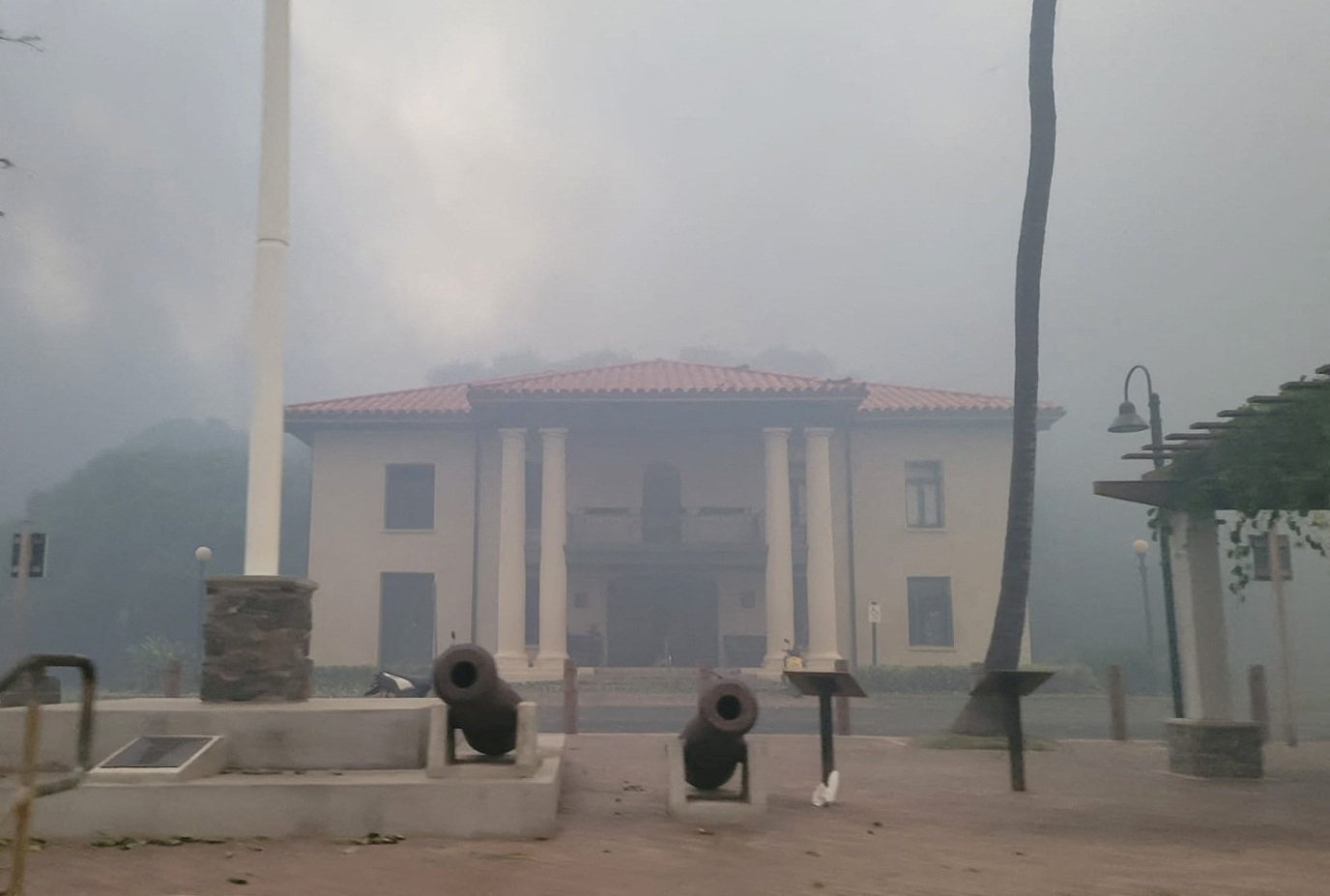
Wildfires have left a trail of destruction on the Hawaiian island of Maui, killing an estimated 53 people and forcing thousands to flee their homes.
The blazes, which continued to rage on Thursday, appear to have devastated the historic centre of Lahaina, the onetime capital of the former Kingdom of Hawaii.
While damage was still being assessed, witnesses said several significant sites appeared to have been consumed by the flames.
Richard Olsten, a helicopter pilot with tour operator Air Maui, told The Associated Press news agency he had flown over the area to take stock.
“All the places that are tourist areas, that are Hawaiian history, are gone, and that can’t be replaced,” he said. “You can’t refurbish a building that’s just ashes now. It can’t be rebuilt — it’s gone forever.”
What has been destroyed?
Aerial footage of Lahaina showed the town nearly engulfed in flames. Videos on social media captured smouldering remains downtown, with cars and storefronts melted.
It was not immediately clear how all of the 60 historic sites in the Lahaina Historic District fared. The district encompasses more than 6,500 hectares (16,000 acres).
Speaking to The New York Times, Theo Morrison, the executive director of the Lahaina Restoration Foundation, which manages several of the historic sites, said the speed of the encroaching fire made it nearly impossible to take any protective action.

“We had no preparation, no warning, nothing,” Morrison said. She noted that the roof of the Old Lahaina Courthouse, which held a heritage museum with ancient Hawaiian artefacts, appears to have collapsed.
Local media also reported that the Baldwin Home, built in 1834 by Reverend Ephraim Spaulding, has been destroyed. The home was the oldest still standing in Lahaina.
Photos on social media appeared to show the famous Lahaina Banyan Tree, believed to be the largest in the United States, also severely singed.
‘Going to change everything’
Longtime residents lamented the loss. The fire is “just going to change everything”, Lee Imada, who worked at the Maui News for 39 years, told The Associated Press.
“It’s just hard to register, even right now, what the full impact of this is going to be.”

Imada said his ancestral ties to Lahaina go back generations. His mother’s family owned a chain of popular general stores, and his great-uncles ran a location on historic Front Street until it closed about 60 years ago.
He recalled walking down Front Street among the tourists as they shopped or ate, looking at the banyan tree and enjoying the beautiful ocean views from the harbour.
“It’s just sort of hard to believe that it’s not there,” Imada said. “Everything that I remember the place to be is not there any more.”
Lahaina and the Kingdom of Hawaii
Lahaina grew to prominence under King Kamehameha I, a transformational figure in Hawaiian history.
He united Hawaii under his rule, conquering smaller independent chiefdoms in Oahu, Maui, Molokai, Lanai, Kauai and Niihau from 1795 to 1810.
In Lahaina, a coastal town framed by volcanic peaks, Kamehameha built a royal residence, known as the Brick Palace, which was one of the first Western-style buildings in the Hawaiian Islands, according to the US National Park Service. Lahainaluna High School became the main site of education for the kingdom’s leaders.
Kamehameha’s successors Prince Liholiho and Prince Kauikeaouli — who ruled as Kamehameha II and Kamehameha III, respectively — resided in Lahaina from 1820 to 1845, when the kingdom’s capital moved to Honululu on the island of Oahu.
The Waine’e Church Cemetery, where several Hawaiian monarchs are buried, remains a sacred site for Native Hawaiians, also known as Kanaka Maoli.
To reporters covering the #MauiFire: Please stop characterizing Front Street and Lahaina Town as a “tourist spot”
It was the original Capital of the Hawaiian Kingdom.
King Kamehameha’s palace is here.
Kānaka Maoli still live here, on their ancestral land from the 1800s.
— Kaniela Ing (@KanielaIng) August 9, 2023
Lahaina “was really the political centre for Hawaii”, Davianna McGregor, a retired professor of ethnic studies at the University of Hawaii at Manoa, told The Associated Press.
She pointed out that Lahaina played a prominent role in the kingdom’s shift from an absolute monarchy to a constitutional monarchy under King Kamehameha III.
The town also became a key port with the first US whaling ships arriving in 1819. Those hunting expeditions, plus the influx of Christian missionaries, brought foreigners and commercialisation to Lahaina. In the following decades, many Chinese citizens also relocated to Lahaina to work on sugar plantations.
After the overthrow of the Kingdom of Hawaii in 1893 and the subsequent annexation of the Hawaiian Islands by the US five years later, Lahaina became one of Hawaii’s largest tourist destinations. The islands became a US state in 1959.







